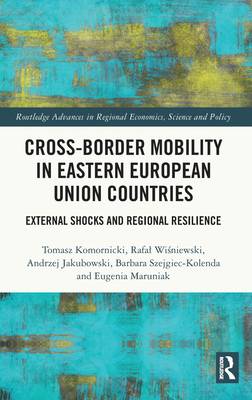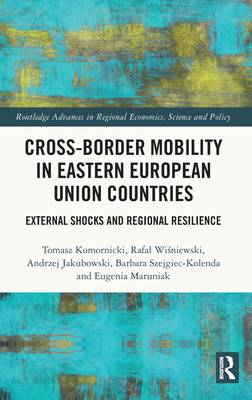
- Retrait gratuit dans votre magasin Club
- 7.000.000 titres dans notre catalogue
- Payer en toute sécurité
- Toujours un magasin près de chez vous
- Retrait gratuit dans votre magasin Club
- 7.000.0000 titres dans notre catalogue
- Payer en toute sécurité
- Toujours un magasin près de chez vous
Cross-Border Mobility in Eastern European Union Countries
External Shocks and Regional Resilience
Tomasz Komornicki, Rafal Wiśniewski, Andrzej Jakubowski, Barbara Szejgiec-Kolenda, Eugenia MaruniakDescription
This book examines how cross-border mobility across the eastern border of Poland with Russia, Belarus and Ukraine, driven by external shocks, influences different territorial units.
It offers a new understanding of the determinants, dynamics, spatial distribution and impact on such mobility in times of upheaval and uncertainty. It provides answers to the following questions: how do the different types of flows of people evolve under various external shocks?; to what extent is cross-border mobility resilient to these shocks in terms of the intensity of flows, their volume and the directions of linkages?; how do rapid and unexpected changes in cross-border mobility affect the performance of national, regional and local social and economic systems?; and to what extent and how does cross-border mobility as triggered by external shocks reinforce, deepen or alter existing spatial regularities and differentiations? Referring to current events such as the COVID-19 pandemic and the war in Ukraine, the book presents evidence of their implications on cross-border mobility, illuminating policy responses with a view to potential future crises. Further, it draws attention to the territorial aspects of changes in the patterns of cross-border population flows that provide a rationale for the territorialisation of relevant policies.
Due to its interdisciplinary character, including issues in the scope of regional economics, human geography and international relations, the book is a timely, valid and unique publication, which will appeal to a broad group of specialists: scholars, researchers and policymakers, as well as decision-makers interested in the socio-economic and political situation in Central and Eastern Europe, particularly on the external border of the European Union.
Spécifications
Parties prenantes
- Auteur(s) :
- Editeur:
Contenu
- Nombre de pages :
- 288
- Langue:
- Anglais
- Collection :
Caractéristiques
- EAN:
- 9781032701752
- Date de parution :
- 09-09-25
- Format:
- Livre relié
- Format numérique:
- Genaaid
- Dimensions :
- 156 mm x 233 mm
- Poids :
- 449 g

Les avis
Nous publions uniquement les avis qui respectent les conditions requises. Consultez nos conditions pour les avis.






